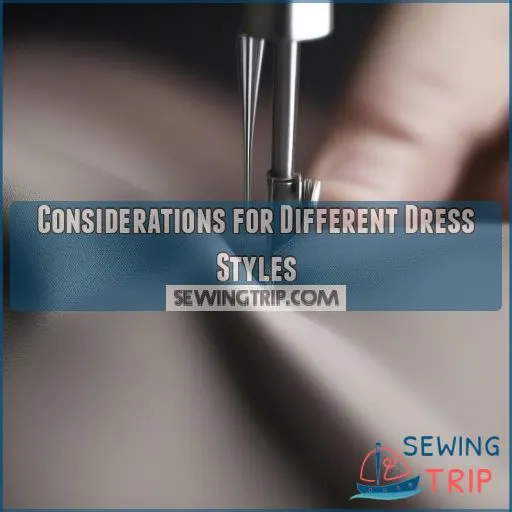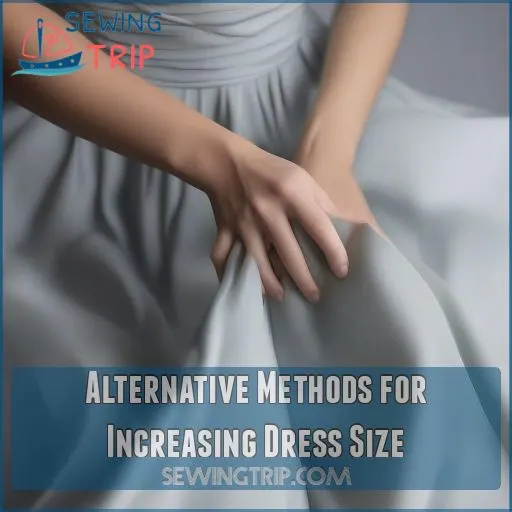This site is supported by our readers. We may earn a commission, at no cost to you, if you purchase through links.

Once you’ve assessed the situation, it’s time to get sewing. Grab your trusty sewing machine and carefully rip out those stitches, then reposition the fabric for a bit more breathing room. Check for common sewing machine problems before you start.
A few strategic pins and some gentle stitching, and voila – your dress will feel like it was made just for you. Trust me, that extra wiggle room is going to make all the difference in your comfort level.
Now go forth and flaunt that fabulous, custom-fitted look!
Table Of Contents
- Key Takeaways
- Assessing Seam Allowances for Letting Out
- Tools and Materials for Seam Alterations
- Step-by-step Process of Letting Out Seams
- Addressing Challenges in Pocket Alterations
- Considerations for Different Dress Styles
- Alternative Methods for Increasing Dress Size
- Finishing Touches and Quality Control
- Frequently Asked Questions (FAQs)
- Conclusion
Key Takeaways
- Measure those seams carefully – the secret to a perfect fit lies in your dress’s construction details. Assess the fabric type, seam allowances, and original stitching to figure out how much wiggle room you have.
- Gather the right tools for the job, from trusty seam rippers to pressing irons. With the right equipment, you will be altering those seams like a pro in no time.
- Get strategic with your seam adjustments. Reposition the fabric, pin and baste carefully, then sew with a reduced seam allowance. Do not forget to press those alterations for a polished finish.
- Do not let pesky pockets or different dress styles trip you up. Whether you are dealing with princess seams or a loose-fitting frock, there are clever techniques to let out your dress and maintain a fabulous fit.
Assessing Seam Allowances for Letting Out
Before you start letting out your dress for a comfier fit, checking the seam allowances is your first important step.
You’ll need to carefully look at everything from the existing seam width to the fabric type, so you can figure out how much room you have to work with.
Measuring Existing Seam Allowances
The secret to a perfect fit lies in your seams.
To measure existing seam allowances, you’ll need:
- A seam gauge or ruler
- Bright lighting
- A magnifying glass
- Patience (trust me, you’ll need it!)
Don’t skimp on this step—it’s the foundation for successful alterations.
Determining Fabric Type and Fraying Tendencies
Now that you’ve measured those seams, let’s talk fabric. You’ll want to pinpoint your dress’s material and its tendency to unravel.
Some fabrics, like silk or linen, fray faster than your grandma’s gossip, while others, such as knits, are more forgiving.
Evaluating Original Dress Construction Methods
After examining fabric types, let’s assess how your dress was put together.
You’ll want to check the seams closely.
Are they straight stitches or serged?
Straight stitches are easier to unpick.
Don’t forget to peek at the bodice – lined ones are usually simpler to alter.
Identifying Number of Vertical Seams
Vertical seams are your dress’s secret weapon for a perfect fit, just like the seam allowance in suit pants gives you room to adjust the length.
Count them up:
- Princess seams: Your BFFs for customization
- Side seams: The go-to for quick fixes
- Back seams: Hidden heroes of comfort
More seams mean more wiggle room for letting out your dress.
Calculating Potential Increase in Garment Size
Having counted your vertical seams, it’s time to do some math!
Measure your body and the dress, then compare.
Calculate how much extra fabric you need overall.
Divide that by the number of seams to determine how much you’ll let out each one.
Tools and Materials for Seam Alterations
You’ll need the right tools to tackle those tricky seam alterations and give your dress some breathing room.
Let’s check out the must-have equipment that’ll make letting out your dress a breeze, from trusty seam rippers to the perfect pressing tools.
Essential Sewing Equipment
You’ve measured your seams, now let’s gear up!
Your trusty sewing machine is your best friend here.
Don’t forget sharp fabric shears and a reliable pressing iron.
Grab your measuring tape and pins too.
With these tools, you’ll be ready to work some dress-altering magic!
Selecting Appropriate Thread and Needles
The right thread and needles can make or break your dress alteration. When letting out seams, choose wisely:
- Match thread weight to fabric thickness
- Select the right needle size based on fabric type
- Consider stretch factor for knits
- Pick a thread color that blends seamlessly
Pressing Tools for Professional Finish
Now that you’ve got your thread and needles sorted, let’s talk pressing.
A good iron is your best friend for achieving that polished look.
Invest in a reliable steam iron and pressing cloth to protect delicate fabrics.
Don’t forget a sturdy ironing board for stability!
Seam Rippers and Unpicking Techniques
A seamstress’s best friend, the humble seam ripper, is your ticket to dress-altering freedom.
Master the art of unpicking with finesse – it’s like performing delicate surgery on fabric!
Choose the right ripper for your thread type and fabric, ensuring a clean slate for alterations.
Measuring and Marking Tools
After unpicking those stitches, it’s time to get precise! Grab your measuring and marking tools – they’re your secret weapons for a flawless fit.
Here’s what you’ll need:
- Measuring tape (for accurate body measurements)
- Tailor’s chalk (for temporary marks)
- Fabric markers (for darker fabrics)
- Marking pencils (for delicate materials)
- Dressmaker’s shears (for clean cuts)
Step-by-step Process of Letting Out Seams
Ready to give your dress some breathing room?
Let’s walk through the step-by-step process of letting out seams,
transforming your snug garment into a comfortable masterpiece that fits like a dream.
Removing Existing Stitches Carefully
You’ve got your tools ready, so let’s get to work!
Grab your seam ripper and gently unpick those stitches.
Take it slow and steady – you don’t want to snag the fabric.
It’s like unraveling a mystery, one thread at a time.
Repositioning Fabric for Increased Width
With the stitches undone, it’s time to give your dress some breathing room.
Here’s how to reposition that fabric:
- Gently pull the seam apart
- Smooth out any wrinkles or creases
- Align the fabric grain for proper drape
Pinning and Basting New Seam Lines
Now that you’ve repositioned the fabric, it’s time for some pin action! Grab those trusty pins and start securing your new seam lines. Don’t skimp on this step – it’s like giving your dress a roadmap to follow.
Basting stitches are your secret weapon here.
Sewing New Seams With Reduced Allowance
Once you’ve prepped your seams, it’s time to get into the details of sewing.
Reduce your seam allowance carefully, stretching the fabric gently as you go.
Adjust your stitch length and thread tension to accommodate the new seam width, making sure to understand how all these components work together for a smooth and even finish.
Pressing and Finishing Altered Seams
Ready to put the finishing touches on your altered dress? Grab your iron and let’s smooth out those seams! Press gently, using a pressing cloth to protect delicate fabrics.
Work from the inside out, creating crisp edges and seamless changes.
Your DIY alteration’s almost complete!
Addressing Challenges in Pocket Alterations
When you need to let out a dress, pockets can be a real head-scratcher.
But don’t worry – with a few clever tricks up your sleeve, you’ll be able to tackle those tricky side seams and slash pockets like a pro, ensuring your newly altered dress fits like a dream without sacrificing functionality.
Strategies for Side Pocket Adjustments
When tackling side pocket adjustments, you’ll face a sartorial puzzle.
If your dress has side pockets, consider moving excess fabric to the center back. This trick can save your pockets while giving you breathing room.
Can’t shift to the back? Time for some pocket wizardry!
Maintaining Pocket Functionality During Alterations
Moving from side pocket adjustments, let’s tackle keeping those pockets functional.
You’ve got options! Reattach pockets to your newly marked side seam, or shift them slightly if needed.
Techniques for Slash Pocket Modifications
- Carefully seam rip the pocket opening
- Gently manipulate fabric to maintain pocket size
- Adjust pocket lining for a seamless fit
- Reinforce pocket corners for durability
Balancing Fabric Distribution With Pocket Placement
As you redistribute fabric, consider how pocket placement affects the overall balance. You’ll want to maintain a flattering silhouette while ensuring pockets remain functional.
Side seams should be adjusted carefully, keeping an eye on how the dress drapes.
It’s like a delicate dance between form and function!
Alternatives for Preserving Pocket Size
Worried about shrinking pockets? Don’t fret! You’ve got options to keep your hands cozy and your belongings secure.
Let’s explore clever tricks to maintain pocket size while letting out those seams.
From adjusting placement to creative fabric additions, we’ll make sure your dress remains both stylish and functional.
Considerations for Different Dress Styles
Different dress styles need different ways to let out seams for a comfortable fit.
Whether you’re dealing with princess seams, fitted bodices, or loose-fitting frocks, we’ll show you expert techniques to get the perfect fit for any dress type.
Adjusting Princess Seams for Added Comfort
Princess seams can be your best friend for creating a comfortable fit.
These long, curved seams run from the armhole to the hem, giving you plenty of room to play.
By carefully adjusting these seams, you’ll achieve a flattering silhouette that feels like a dream.
Techniques for Altering Fitted Bodices
If you need to alter a fitted bodice, you’ve got options.
Start by identifying the bodice seams and darts.
You’ll need to carefully unpick these areas, adjusting for a better fit.
Remember, different fabric types require specific techniques.
Don’t be afraid to take in or let out as needed.
Strategies for Loose-fitting Dress Alterations
Unlike fitted bodices, loose dresses offer more room to play.
You’ll want to focus on maintaining the garment’s overall shape while creating a better fit.
Consider taking in side seams or adding darts strategically.
Modifying Dresses With Linings or Facings
While loose-fitting dresses offer wiggle room, lined garments present a unique challenge.
You’ll need to tackle both layers simultaneously.
Start by carefully seam ripping the lining.
Then, adjust the outer fabric and lining together, ensuring they move as one harmonious unit for a polished finish.
Approaches for Stretch Fabric Garments
Stretch fabrics can be tricky to alter, but don’t throw in the towel just yet! You’ll want to think about the garment’s stretch and elastic recovery.
Seam ripping requires extra care to maintain fabric stability.
Keep seam allowances generous, as these materials tend to spring back after sewing.
Alternative Methods for Increasing Dress Size
When letting out seams isn’t enough to make your dress fit comfortably, don’t despair – there are plenty of other tricks up a seamstress’s sleeve.
From adding fabric panels to creating a corset back, these alternative methods can help you achieve the perfect fit without compromising on style or comfort.
Adding Fabric Panels for Extra Width
When your dress feels like a straitjacket, adding fabric panels can be a game-changer. This tailoring trick offers extra breathing room without sacrificing style.
Here’s what you need to know:
- Choose complementary fabrics
- Consider panel placement carefully
- Stitch panels securely
- Blend seamlessly with existing design
Incorporating Gussets for Targeted Expansion
Gussets are your secret weapon for targeted dress expansion! These fabric inserts can work wonders, giving you extra room right where you need it.
Let’s explore how to incorporate gussets effectively:
| Gusset Type | Best For | Difficulty |
|---|---|---|
| Triangle | Armholes, Hips | Easy |
| Diamond | Bust, Waist | Moderate |
| Rectangle | Side Seams | Easy |
| Oval | Curved Areas | Advanced |
| Custom | Unique Designs | Varies |
Creating a Corset Back for Adjustable Fit
Creating a corset back can be a game-changer for your dress fit.
You’ll transform that snug gown into a flexible masterpiece!
By swapping out a section of the back for lacing, you’re giving yourself room to breathe – and adjust – on the fly.
Utilizing Darts for Shape and Comfort
While corset backs offer flexibility, darts can be your secret weapon for a perfect fit.
You’ll love how these simple folds transform your dress’s shape.
By adjusting existing darts or adding new ones, you can create room exactly where you need it, enhancing both comfort and style.
Exploring Creative Design Solutions
Thinking outside the box can breathe new life into a snug dress.
You’ve got options beyond just letting out seams.
Try adding fabric panels for extra wiggle room, or get creative with a corset back.
These tricks can transform your dress without sacrificing style.
Finishing Touches and Quality Control
You’ve done the hard work of letting out your dress seams, but don’t pop the champagne just yet.
These final steps will make sure your alterations look professional and feel comfortable, so you can rock that dress with confidence.
Ensuring Even Seam Allowances Throughout
You’ve expanded your dress, but don’t rush to the finish line yet! Even seam allowances are the secret sauce for a polished look.
Grab your measuring tape and get ready to play detective.
We’ll make sure those seams are as consistent as your grandma’s cookie recipe.
Addressing Any Visible Alteration Marks
After letting out seams, you might spot some telltale marks.
Don’t fret! Blending these alterations is an art.
Try matching thread colors precisely, concealing old stitch lines with fabric markers, or camouflaging them with strategic pressing.
With a bit of patience, you’ll be minimizing those pesky signs in no time.
Reinforcing High-stress Areas After Alterations
Don’t forget to reinforce high-stress areas like buttons, zippers, and hems after your alterations.
A few extra stitches can make all the difference in keeping your dress looking polished and preventing future rips or tears.
Take your time – it’s worth it!
Final Pressing and Shaping Techniques
Ironing techniques are the cherry on top of garment finishing.
Use steam pressing for shaping curves and pleat pressing for crisp lines.
Here’s your toolkit:
- A quality iron with steam functions
- Pressing cloths for delicate fabrics
- Tailor’s ham for shaping
Conducting Fit Tests and Making Adjustments
During your fit test, check if the dress drapes comfortably.
Make any final adjustments until it feels like a second skin.
Trial runs in different lighting reveal hidden flaws.
Use adjustment techniques to tailor the fit, ensuring a seamless look.
Frequently Asked Questions (FAQs)
Can seams be let out on delicate fabrics?
You can let out seams on delicate fabrics like silk, but it’s trickier.
Use a fine needle and consider a professional, because these fabrics are as unpredictable as a cat’s mood—stitches show, fraying sneaks in.
What is the impact on garment aesthetics?
Channel your inner Picasso while altering seams: expect a little color pop when dyed areas resurface.
Creative minds know altering delicate dresses might shift the masterpiece, revealing secrets like visible stitch lines or uneven patterns using proper sewing techniques.
How does fabric type influence seam durability?
Fabric type plays a big role in seam durability.
Delicate fabrics like silk and linen need smaller seam allowances to avoid fraying, while knits can handle tighter seams without compromising strength.
Consider the fabric when planning your dress alterations.
Are there limits to seam letting out?
A stitch in time saves nine, but limited seam allowance can stop you from letting out too much.
Check seam allowances and fabric integrity; too little room may require creative solutions like adding panels or seeking professional tailoring.
How do measurements affect seam alterations?
Measurements often reveal how much seam allowance you need to adjust.
By comparing your body’s dimensions with the dress, you figure out the required seam alterations, ensuring it fits like a glove rather than a straightjacket.
Conclusion
It’s ironic how those extra inches of ignored fabric can transform a dress from constricting to liberating.
By mastering the art of letting out seams for comfort, you breathe new life into garments that once felt limiting.
Equipped with these tips, you’ll confidently alter seams, tackle pockets, and even add panels when needed.
Get ready to strut in your revitalized, custom-fitted wardrobe!













